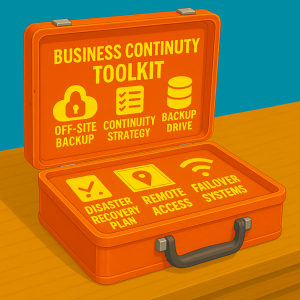 When disaster hits, will your business stay standing or go dark?
When disaster hits, will your business stay standing or go dark?
Whether it is a cyberattack, power outage, hardware failure, or natural disaster, IT interruptions can cripple small to mid-sized businesses. Many assume having a basic data backup solution is enough, but here is the hard truth: data backups alone do not guarantee business continuity.
When your systems go offline and your team can’t access critical tools or serve clients, the real cost of downtime begins. That is where a full business continuity and disaster recovery (BCDR) strategy becomes essential.
Do Not Confuse Backups with Business Continuity
A daily backup file may recover your data but can it restore your operations?
Business continuity planning is about more than restoring files. It ensures your organization can maintain essential functions during and after an IT incident. Without a solid incident response and disaster recovery plan, your business is vulnerable to extended outages, revenue loss, regulatory penalties, and reputation damage.
Key Differences: Data Backup vs. Business Continuity
Data Backup:
- Creates copies of your data
- Often stored locally or in the cloud
- Useful for restoring files after data loss
Business Continuity & Disaster Recovery:
- Ensures your systems, people, and processes stay operational
- Includes remote access, recovery time objectives (RTOs), and redundant systems
- Enables rapid recovery after a security incident, power outage, or natural disaster
The Must-Haves for True Business Continuity
If your current IT provider can’t walk you through these essentials, it is time to reevaluate:
✅ Immutable, encrypted off-site backups
✅ Defined RTO and RPO (Recovery Time/Point Objectives)
✅ Secure remote work capabilities
✅ Redundant systems and network failovers
✅ Routine disaster recovery testing and simulations
✅ Compliance-ready plans for HIPAA, SOC2, and industry standards
A proactive approach helps avoid the high costs of unplanned downtime and builds long-term resilience.
Why Disaster Recovery Matters: Real-World Examples
Still think it won’t happen to you? Consider:
- Ransomware attacks have paralyzed countless SMBs overnight, leaving them without access to invoices, CRM systems, or even payroll files.
- Flooding in the Southeast wiped out physical servers for businesses without cloud-based disaster recovery, costing months of records.
- Wildfires and hurricanes have destroyed physical offices, making businesses with no remote access completely inoperable.
Disasters are not a matter of “if,” they are a matter of “when.”
5 Questions Every Business Should Ask Their IT Provider
Do not wait until a crisis to discover vulnerabilities. Ask your IT partner:
- Do we have a formal incident response plan?
- Are our backups tested regularly and include all mission-critical systems?
- What is our disaster recovery timeline if we lose access to our office or data?
- Can our team maintain secure, remote operations in an emergency?
- Are our business continuity protocols compliant with regulations like HIPAA, PCI, or SOC2?
If you are not confident in the answers, you are not prepared.
You Can’t Prevent Every Incident, But You Can Prevent Downtime.
The right IT partner will not just help you recover, they will help you stay resilient.
At TSR Solutions, our business continuity and disaster recovery services ensure your business remains secure, compliant, and operational, no matter what comes your way.
Ready to test your readiness?
Schedule your FREE Network Assessment today. Let’s turn disaster planning into peace of mind.



